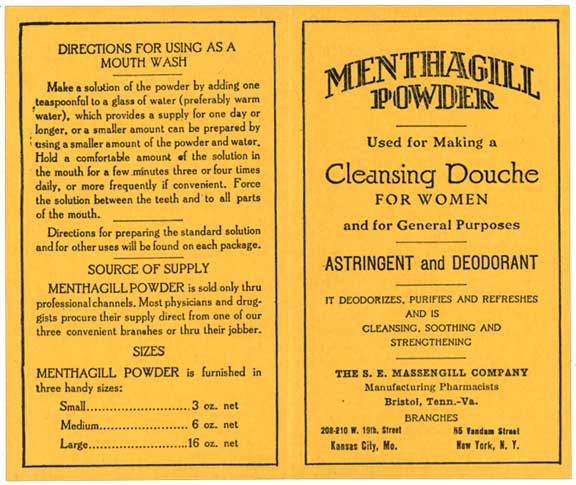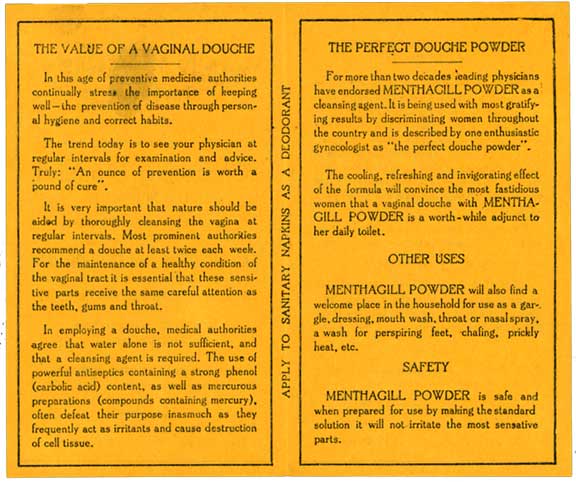1964 Enovid
(U.S.A.) birth-control pill package &
directions with booklet Planning Your Family
(also 1964) addressed to married women, not
single.
Pro-Fo Lactic
(U.S.A., 1930-40s?) Either a contraceptive
or treatment for STDs (sexually transmitted
diseases), or both. Ointment with a bag to
contain penis.
Fresca douche powder
(early 20th century, U.S.A.); the label
contains language possibly hinting at
contraceptive use.
See also early
contraceptive sponges disguised for other uses.
Ad for Ergoapiol, treatment for painful or
missing menstrual periods or other
irregularities of the menstrual cycle - or
for abortion, 1904.


|

MUSEUM OF MENSTRUATION AND WOMEN'S
HEALTH
Menthagill Powder (leaflet)
The S. E. Massengill Company, Bristol,
Tenn.-Va. (U.S.A., 1920s?)
Nowhere does it say what the
douche powder's made of. It might
be baking soda with a yellow dye.
But a clue is Menth-.
Does it stand for menthol?
Read the Perils
of Vaginal Douching - but
you already know you shouldn't
normally douche.
After this Web page appeared, a
retired teacher who has
contributed much valuable
information and many items to
this museum wrote, in part:
Harry,
I checked your updates tonight
and saw where you were
speculating about the
[Massengill] contents and it
would have been good if they had
been so benign.
Now the ones you buy do have
backing soda or vinegar but not
back then. Part of the problem
was the time period [the 1930s
and before], lack of treatment
for STD's but worse is the
unqualified chemist who worked
for them in the Thirties.
This link is about the douches:
http://bmartinmd.com/2009/03/a-few-words-about-massengill-d.html
But this one is about the more serious
product created by them and
the many deaths and lawsuits.
I think in the spirit of
women's health and history you
should do a little more summary
on this topic and/or some links
to this:
http://bmartinmd.com/cgi-bin/mt/mt-search.cgi?tag=Elixir%20of%20Sulfanilamide&IncludeBlogs=1&IncludeBlogs=1
"In the fall of 1937, more
than 100 US citizens -- many
children -- died after consuming
Elixir of
Sulfanilamide, a
raspberry-flavored antibiotic
syrup manufactured by the S. E.
Massengill Pharmaceutical
Company of Bristol, Tennessee.
The difficult-to-dissolve
antibiotic was mixed with the solvent
diethylene glycol, a known
toxin, by the company's
uninformed head chemist, Harold
Cole Watkins. Watkins reportedly
tested the elixir only for its
appearance and palatability
before its nationwide
distribution. The
catastrophic event led to the
passage of the 1938 Federal
Food, Drug, and Cosmetic Act."
"On December 28, 1937, a
settlement of $1000 was made by
the S. E. Massengill Company in
response to the death."
Read a short
article in Time magazine in
1938 about this tragedy.
I thank
the donor!
|
Below:
Pages (exterior) 4 & 1. Each
of the 4 pages measures 2 3/4 x 4
3/4" (7 x 11.8 cm).
|
 |
Below:
Pages (interior) 2 & 3. See more powder for
menstrual pads:
Amolin
(U.S.A., from Kotex) produced from
the 1920s to probably the 1970s.
Mum
deodorant (U.S.A.) produced from
at least the 1920s and still sold
today (2000)
Quest
(U.S.A., 1930s - ?)) two cans and
an ad
It's amazing how companies and
the medical establishment
promoted douching,
which you
shouldn't do.
|
 |
1964 Enovid (U.S.A.)
birth-control pill package & directions
with booklet
Planning Your Family
(also 1964) addressed to married women, not
single.
Pro-Fo Lactic
(U.S.A., 1930-40s?) Either a contraceptive
or treatment for STDs
(sexually transmitted diseases), or both.
Ointment with a bag to contain penis.
Fresca douche powder
(early 20th century, U.S.A.); the label
contains language
possibly hinting at contraceptive use.
Egyptian
hieroglyphics
from about 1550 B.C.E. describing a tampon used
for contraception
© 2011 Harry Finley. It is illegal to
reproduce or distribute any of the work on
this Web site
in any manner or medium without written
permission of the author. Please report
suspected
violations to hfinley@mum.org\
|